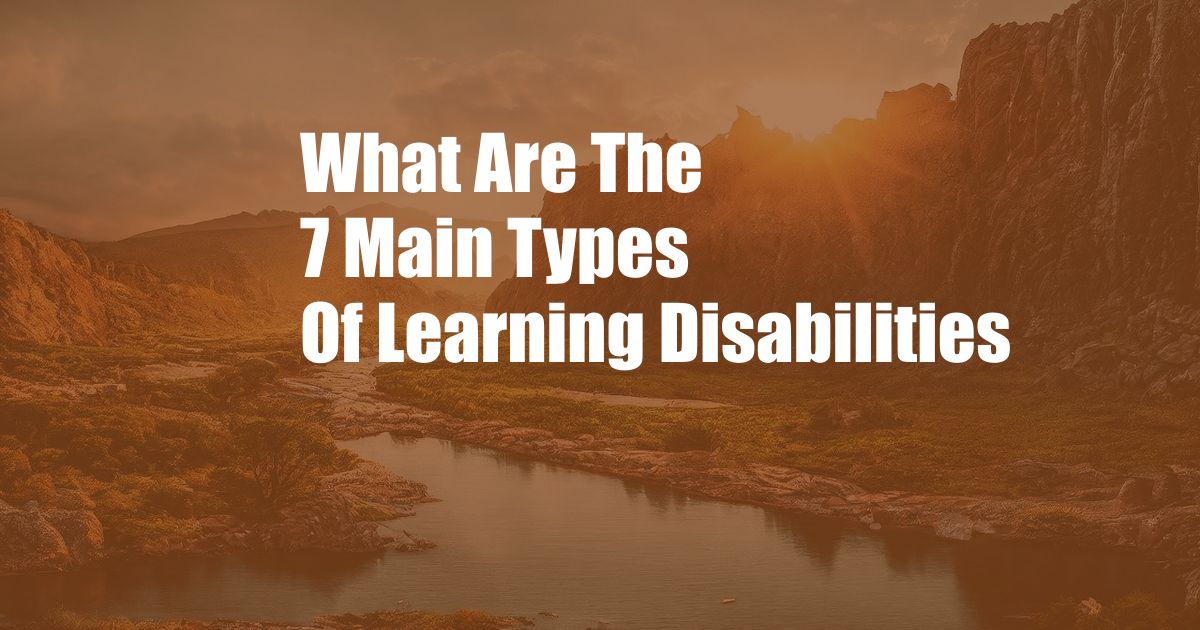
What Are the 7 Main Types of Learning Disabilities?
Learning disabilities (LDs) are a group of disorders that affect a person’s ability to learn and use academic skills. LDs can make it difficult for a person to read, write, spell, or do math. They can also affect a person’s ability to pay attention, follow directions, or organize their thoughts.
LDs are not caused by a lack of intelligence. They are caused by differences in the way a person’s brain processes information. LDs can be mild, moderate, or severe. They can also affect people of all ages.
History and Meaning of Learning Disabilities
The term “learning disability” was first used in the 1960s. Before that, children with LDs were often thought to be lazy, unmotivated, or stupid. Today, we know that LDs are caused by real differences in the way a person’s brain works.
LDs are a common problem. They affect about 10% of school-aged children. LDs can make it difficult for a child to succeed in school. However, with the right help, children with LDs can learn to cope with their challenges and reach their full potential.
Types of Learning Disabilities
There are seven main types of LDs. These are:
- Dyslexia: Dyslexia is a difficulty with reading. People with dyslexia may have trouble recognizing words, decoding words, or understanding what they read.
- Dysgraphia: Dysgraphia is a difficulty with writing. People with dysgraphia may have trouble forming letters, spelling words, or organizing their thoughts on paper.
- Dyscalculia: Dyscalculia is a difficulty with math. People with dyscalculia may have trouble understanding numbers, doing math problems, or solving word problems.
- Dyspraxia: Dyspraxia is a difficulty with movement and coordination. People with dyspraxia may have trouble with fine motor skills, such as writing or tying their shoes. They may also have trouble with gross motor skills, such as running or jumping.
- Auditory processing disorder: Auditory processing disorder (APD) is a difficulty with understanding spoken language. People with APD may have trouble following directions, understanding what people are saying, or remembering what they hear.
- Visual processing disorder: Visual processing disorder (VPD) is a difficulty with understanding visual information. People with VPD may have trouble recognizing objects, understanding pictures, or following directions.
- Nonverbal learning disorder: Nonverbal learning disorder (NLD) is a difficulty with nonverbal communication. People with NLD may have trouble understanding facial expressions, gestures, and body language. They may also have trouble with social skills.
Latest Trends and Developments
In recent years, there have been a number of new developments in the field of LDs. These developments include:
- The use of technology to help people with LDs. Technology can be used to help people with LDs with a variety of tasks, such as reading, writing, and math.
- The development of new teaching methods for people with LDs. New teaching methods are being developed that are designed to meet the specific needs of people with LDs.
- A greater awareness of LDs. There is a growing awareness of LDs among parents, teachers, and the general public. This awareness is leading to better diagnosis and treatment for people with LDs.
Tips and Expert Advice
If you think your child may have a learning disability, there are a number of things you can do. These include:
- Talk to your child’s teacher. Your child’s teacher can observe your child in the classroom and provide you with feedback about their academic performance.
- Get a professional evaluation. A professional evaluation can help to diagnose your child’s LD and recommend appropriate treatment.
- Provide your child with support. Children with LDs need extra support from their parents and teachers. This support can include providing your child with extra time for assignments, breaking down tasks into smaller steps, and providing positive reinforcement.
FAQ
Q: What are the symptoms of a learning disability?
A: The symptoms of a learning disability can vary depending on the type of LD. However, some common symptoms include:
- Difficulty with reading, writing, or math
- Difficulty with paying attention or following directions
- Difficulty with organization or planning
- Difficulty with social skills
- Difficulty with motor skills
Q: How are learning disabilities diagnosed?
A: Learning disabilities are diagnosed through a process of evaluation. This evaluation may include:
- A review of your child’s academic records
- An observation of your child in the classroom
- A psychological evaluation
- A physical examination
Q: What are the treatments for learning disabilities?
A: The treatment for a learning disability will vary depending on the type of LD. However, some common treatments include:
- Special education services
- Speech therapy
- Occupational therapy
- Physical therapy
- Medication
Conclusion
Learning disabilities are a common problem. However, with the right help, children with LDs can learn to cope with their challenges and reach their full potential. If you think your child may have a learning disability, talk to your child’s teacher or get a professional evaluation.
Are you interested in learning more about learning disabilities?
If so, here are some additional resources:
- The National Center for Learning Disabilities: https://www.ncld.org/
- The Learning Disabilities Association of America: https://ldaamerica.org/
- The Understood.org website: https://www.understood.org/en